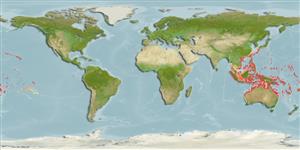>
Eupercaria/misc (Various families in series Eupercaria) >
Labridae (Wrasses)
Etymology: Gomphosus: Greek, gomphos = nail; also molar tooth.
More on author: Lacepède.
Environment: milieu / climate zone / depth range / distribution range
Ökologie
seewasser riff-verbunden; tiefenbereich 0 - 35 m (Ref. 90102), usually 2 - 30 m (Ref. 27115). Tropical; 24°C - 28°C (Ref. 27115); 30°N - 30°S, 43°E - 143°W
Indo-Pacific: Cocos-Keeling to the Hawaiian, Marquesas and Tuamoto islands, north to southern Japan, south to Rowley Shoals in the eastern Indian Ocean and Lord Howe and Rapa islands. Replaced by Gomphosus caeruleus in the Indian Ocean (Ref. 37816). Hybrid with Thalassoma lunare documented from Cassini Island, Western Australia and reported from the Great Barrier Reef; with Thalassoma duperrey, observed from Hawaii (Ref. 57557).
Size / Gewicht / Alter
Maturity: Lm ? range ? - ? cm
Max length : 30.0 cm SL Männchen/unbestimmt; (Ref. 9823)
Rückenflossenstacheln (insgesamt): 8; Rückenflossenweichstrahlen (insgesamt): 13; Afterflossenstacheln 3; Afterflossenweichstrahlen: 11. Identified by long snout when adult and distinguished by color or geography from its sibling G. caeruleus (Ref. 48636). Small juveniles lack the elongate snout (Ref. 37816).
A solitary species (Ref. 90102) found in coral-rich areas of lagoon and seaward reefs to a depth of at least 30 m (Ref. 1602, 58302). Benthopelagic (Ref. 58302). Feeds mainly on small benthic crustaceans, sometimes on small fishes, brittle stars, and mollusks (Ref. 2334). Minimum depth reported taken from Ref. 128797.
Life cycle and mating behavior
Geschlechtsreife | Fortpflanzung | Ablaichen | Eier | Fecundity | Larven
Oviparous, distinct pairing during breeding (Ref. 205).
Randall, J.E., G.R. Allen and R.C. Steene, 1990. Fishes of the Great Barrier Reef and Coral Sea. University of Hawaii Press, Honolulu, Hawaii. 506 p. (Ref. 2334)
IUCN Rote Liste Status (Ref. 130435)
Bedrohung für Menschen
Harmless
Nutzung durch Menschen
Warning: mysqli::__construct(): (HY000/1040): Too many connections in /var/www/html/includes/func_getlabel.php on line 46
Can't connect to MySQL database (fbapp). Errorcode: Too many connections
